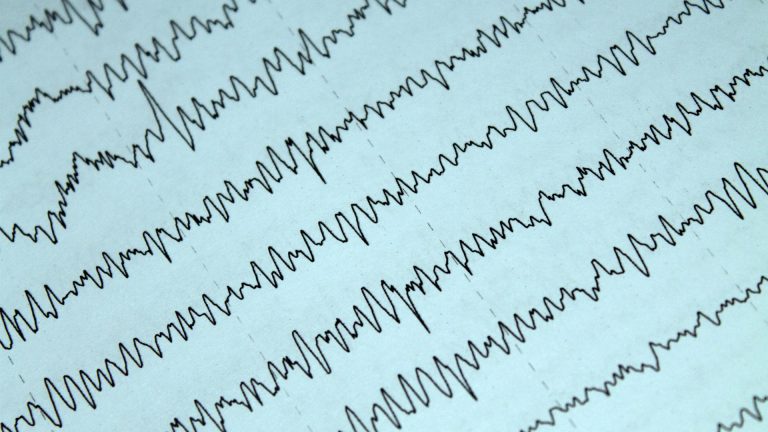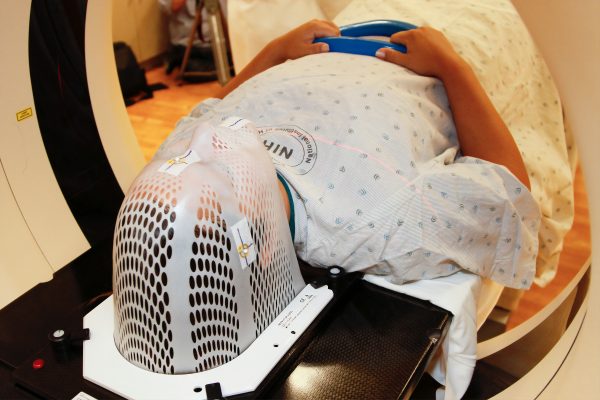by: Amy Wise
Every second of every day, every network of cells in our brain is sending signals at specific rhythms that allow us to transmit an enormous amount of information. Brain cells communicate with each other through electrical impulses. An electroencephalogram (EEG) is a test used to evaluate the electrical activity in the brain that can be used to help detect potential problems associated with this activity. An EEG operates by tracking and recording brain wave patterns. Small flat metal discs called electrodes are attached to the scalp with wires. The electrodes sense the electrical impulses in the brain and send the signals to a computer that records the results. The electrical impulses in an EEG recording look like wavy lines with peaks and valleys and allow doctors to quickly assess whether there are abnormal patterns in neuronal activity. Any irregularities may be a sign of seizures or other brain disorders(Subaraja and Vanisree, 2016).
EEGs are powerful brain recording devices that are used in wide ranges of research and are incredibly useful for evaluating seizures in epileptic patients However, they have a few nontrivial drawbacks. They are often in opposition to tangles of tens to hundreds of wires and require smearing electrode gel all throughout the hair of the subject in the simple attempt of achieving an accurate reading. EEGs are very. They also require either waiting for the patient to have a spontaneous seizure or evoking a seizure every time the patient comes to see the doctor. Especially for children, this process can be grueling and is not always the most efficient way to monitor the natural activity of their brain. Fortunately, a new piece of neuroimaging technology has recently been released that allows a wireless use of an EEG!
Robert Knight, a professor at UC Berkeley, has published EEG data for over two decades concerning the most pressing questions in neuroscience today. This past year, his lab released a comparison study of dry and wet EEG methods to understand if they are truly interchangeable. This study provides a systematic comparison in data quality and electrophysiological measures between a state-of-the-art and wired wet EEG system with 64 electrodes, and a compact and wireless dry EEG system with 31 electrodes. For each subject, they collected EEG recordings from each system. Tests were run on separate days, during rest periods, with eyes open and eyes closed, followed by two versions of a rapid serial visual presentation (RSVP) target detection task in order to collect a variety of EEG data.
In RSVP, a series of stimuli appear rapidly in time at the same point in visual space. The stimuli may appear as fast as 10 items per second and are usually letters or photographs. The task of the participant is to determine when a particular stimulus appears and to press a button or key as fast as possible after that stimulus occurs. For example, the participant might be following a series of letters flashed 10 per second, with their task being to press a response button every time the letter S occurs(Kam et al., 2019).
The designed clinical applications for the wireless EEG included being able to monitor epileptic seizures in order to develop a more accurate understanding of behavior. Even the most attentive parents may unintentionally miscount their how many seizures their child is having a day simply because seizures may present themselves in different ways.
Thus, when developing an effective epileptic treatment, it is helpful to know the exact amount and location of the seizures. Instead of having to induce or wait for seizures each time in a clinical setting, an at-home system for monitoring epileptic seizures is incredibly important for implementing treatment efficiently.
Despite the obvious benefits of a commercial at home EEG system, a more aversive side of this development is neuromarketing. Neuromarketing includes the direct use of brain imaging, scanning, or other brain activity measurement technology to measure a subject’s response to specific products, packaging, advertising, or other marketing elements. Thus, if a person is wearing the EEG that is sold commercially and connected to any of these companies, there would be potential for their data to be used for neuromarketing purposes.
Every new technology faces privacy and security challenges, and brain measuring devices are not exempt. However, the potential benefits of the wireless EEG are truly endless in the clinical field. The ability to measure a patient’s brain activity in their natural environment over long periods of time is certainly useful for understanding a multitude of neurological illnesses and deficits.
The research by the Knight Lab at UC Berkeley has demonstrated that the wireless is equally comparable in collecting EEG data. Therefore, it will only be a matter of time before more hospitals are implementing the wireless EEG system and that neurologists will be taking advantage of the ability to understand their patients’ brains from home!
Image credit: NomeVisualizzato







